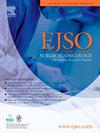P16/HPV-negative oropharyngeal squamous cell carcinoma survival: Comparing primary surgery to primary chemoradiotherapy. A systematic review and meta-analysis
IF 3.5
2区 医学
Q2 ONCOLOGY
引用次数: 0
Abstract
Objectives
This study investigated differences in survival for p16/HPV-negative OPSCC patients treated with primary surgery versus primary (chemo-)radiation therapy (CRT).
Materials and methods
PubMed, CINAHL and Web of Science databases and the online Cochrane Library were searched for relevant English language studies describing the survival outcomes of p16/HPV-negative OPSCC patients treated with primary surgery or primary CRT. The primary endpoint was the 5-year OS; the secondary endpoints included 5-year DSS and DFS, and 3- and 2-year OS, DSS and DFS. The pooled survival curves were estimated using a distribution-free approach assuming random effects. Cumulative KM curves for OS, DSS and DFS were built for each treatment group.
Results
Twenty-two publications were included in the final analysis. Patients included (n = 1903) were divided according to treatment (“surgery” group, n = 942; “RT/CRT” group, n = 961). For all the endpoints, surgery demonstrated improved short- and long-term survival compared to RT/CRT, although selection bias may have impacted the outcomes. The estimated pooled 5-year OS for the surgery and the RT/CRT group was 54.1 % (95 % CI: 44.4%–65.9 %) and 45.7 % (95 % CI: 41.8%–49.9 %), respectively.
Conclusion
Primary surgery and primary CRT for p16/HPV-negative OPSCC both provide acceptable survival outcomes, although in many cases surgery has shown improved survival rates. Further research should focus on when each treatment modality should be used to achieve the goals of treatment completion, survival and functional outcomes.
P16/ hpv阴性口咽鳞状细胞癌的生存:比较初次手术和初次放化疗。系统回顾和荟萃分析
材料与方法在PubMed、CINAHL和Web of Science数据库以及在线Cochrane图书馆中搜索了描述p16/HPV阴性OPSCC患者接受初级手术或初级CRT治疗后生存结果的相关英文研究。主要终点为 5 年 OS;次要终点包括 5 年 DSS 和 DFS,以及 3 年和 2 年 OS、DSS 和 DFS。假设随机效应,采用无分布方法估算了汇总生存曲线。为每个治疗组建立了OS、DSS和DFS的累积KM曲线。纳入的患者(n = 1903)按治疗方法划分("手术 "组,n = 942;"RT/CRT "组,n = 961)。与 RT/CRT 相比,手术治疗提高了所有终点的短期和长期生存率,但选择偏倚可能会影响结果。手术组和 RT/CRT 组的 5 年总 OS 分别为 54.1%(95% CI:44.4%-65.9%)和 45.7%(95% CI:41.8%-49.9%)。进一步的研究应关注每种治疗方式应在何时使用,以实现治疗完成、生存和功能结果的目标。
本文章由计算机程序翻译,如有差异,请以英文原文为准。
求助全文
约1分钟内获得全文
求助全文
来源期刊

Ejso
医学-外科
CiteScore
6.40
自引率
2.60%
发文量
1148
审稿时长
41 days
期刊介绍:
JSO - European Journal of Surgical Oncology ("the Journal of Cancer Surgery") is the Official Journal of the European Society of Surgical Oncology and BASO ~ the Association for Cancer Surgery.
The EJSO aims to advance surgical oncology research and practice through the publication of original research articles, review articles, editorials, debates and correspondence.
 求助内容:
求助内容: 应助结果提醒方式:
应助结果提醒方式:


